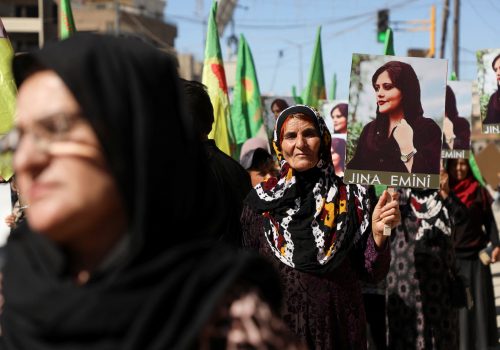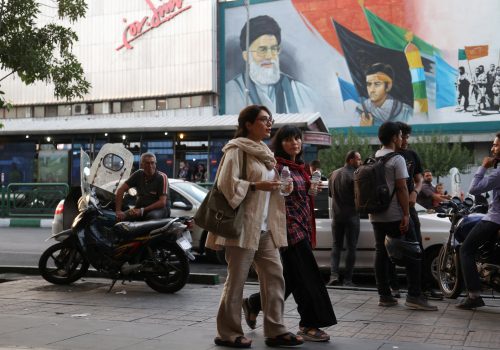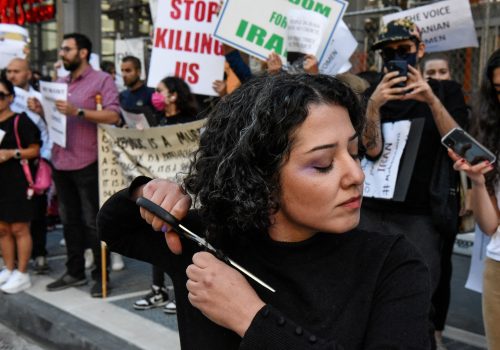A pilgrimage of love: Mourning the dead in defiance of the Islamic Republic
His white hair and beard tussling like a glorious mane, Mashallah Karami walked towards the grave of his twenty-two-year-old son, national karate champion Mohammad Mehdi, who was executed in January over his role in the Woman, Life, Freedom uprising. Iran’s heart revibrated to the soft rhythm of his steps—a father’s pilgrimage of love.
Agha Mashallah, as he is known, got up before dawn on August 19 and walked over fifty-five miles (ninety kilometers) to get from his home to the cemetery where his son was buried. He recorded a video of himself during the journey. “Salute, dear people of my homeland. It’s almost five in the morning. I started walking to the cemetery at one…I just want Komar to know how much I love him,” he said, calling his son by his Kurdish name. “I just want him to know that I remember him, that his love is driving me to take every and each of these steps.”
Arriving at his son’s grave, Agha Mashallah kneeled on the ground and kissed the image of his son engraved on the white tombstone. On August 22, four days after the video of his journey went viral, security forces arrested Agha Mashallah. They also raided his home, confiscating mementos he had of his martyred son, including the gold medals Komar had won in karate competitions, which were all arranged in a display at his humble home—a shrine of love.
“I love you, dad. You have always had my back. You have never let my heart grow cold. You have never let us see your wounds,” an old Instagram post of Komar reads, accompanied by a photo of him with Agha Mashallah.
Agha Mashallah has not been the only target of state persecution over demanding justice for the killing of a loved one. With the anniversary of Mahsa Jina Amini’s state killing looming large on the horizon, over the past weeks, the regime has harassed, threatened, detained, and exiled relatives of the victims of state violence. Despite the relentless persecution, love and life have continued to move people to commemorate the brave fallen of the uprising.
Supreme Leader’s death cult
Over the past four decades, the clerical establishment in Iran—led by Supreme Leader Ayatollah Ali Khamenei and, before him, the founder of the Islamic Republic, Ayatollah Ruhollah Khomeini—has concocted an interpretation of Shia Islam that celebrates death above all.
This dogmatic ideology has helped the Islamic Republic establish its power, survive the eight-year Iran-Iraq war of the 1980s, which claimed over one million lives, and quash any form of dissent through thousands of political executions and hundreds of gruesome assassinations. The regime has also been exporting its ideology through campaigns of terror and covert operations throughout the Middle East, upending the lives of hundreds of millions while sowing death and destruction through proxy wars over geopolitical power and natural resources. However, no despot has ever been able to permanently tame the greatest force on earth: the force of life. The clerical establishment in Iran has been no exception.
The Islamic Republic’s grip on power has been gradually loosening over the years. Despite many hurdles, thanks to the Internet, more people in Iran (especially the youth) are tearing the dark veil that has separated them from the world and their roots. They have shed the chains of the Supreme Leader’s death cult, refused the promised paradise after death, and demanded prosperity in life.
Perceiving this existential threat, the regime has deployed all its resources to bolster its ideological grip on society. In one effort, the state spent millions of dollars on a religious pop song, “Salute Commander,” to indoctrinate children. State-organized concerts were held across Iran, during which children performed the song, pledged their lives to the Supreme Leader, and vowed to even “sacrifice” their parents’ lives for the eighty-four-year-old Ayatollah.
As always, the Islamic Republic’s poison has not remained confined to Iran’s borders. Using the country’s scant and shrinking financial resources, the regime has sponsored and encouraged song performances in other countries, including Lebanon, Iraq, Russia, Pakistan, Myanmar, Kuwait, Bahrain, Bosnia, Nigeria, and even the US.
Additionally, over the past years, the regime has been promoting, facilitating, and organizing the annual Arbaeen pilgrimage, which marks the end of the forty-day mourning period for the anniversary of the death of Shia Saint Hossein, the grandson of the Prophet Mohammad. For the event, millions of Shia Muslims flock to the Iraqi city of Karbala every year, where Imam Hossein is buried. The event allows the regime to indoctrinate participants into its ideology of celebrating death in Allah’s way, positioning martyrdom as the “highest achievement” in life.
In recent weeks, as part of the regime’s efforts to display a return to “normalcy” after the recent uprising, the state has gloated over the fact that hundreds of thousands of Iranians have registered to participate in the pilgrimage. However, the sweetness of this presumed victory has turned into ashes in the mouth of the Supreme Leader.
A forest rises from the graves
When Amini was killed in the custody of the so-called morality police for allegedly “violating” mandatory hijab, her parents marked her grave with a short tribute in Kurdish: “Dear Jina, you shall never die. Your name will turn into a symbol.”
Indeed, her name turned into a banner under which people in Iran rose up and demanded the fall of the clerical establishment. In response, the regime, as always, unleashed brute force, arresting at least twenty-two thousand people and killing at least 537 more—dozens of children among them.
However, every person killed by the regime has turned into a seed, and from their grave, a glorious forest has been born, standing tall and defiant. People like Agha Mashallah have been tending to this forest. His love has not been limited to his lost son. It has grown to embrace others, including Mohammad Hosseini, a young man executed on the same day as Komar over the former’s role in protests. Since Hosseini has no living relatives, Agha Mashallah has embraced him as a son, cherishing his memory. Following Komar and Hossein’s executions, Agha Mashallah has been preparing food from his scant income and distributing it among the poor every week. Over the months, Agha Mashallah’s hands, which have become calloused from hard work, his soft voice, kind smile, and his indiscriminate love have earned him the title of the “nation’s father.”
On his pilgrimage to his son’s grave, Agha Mashallah addressed the nation: “I’m really grateful that you have always kept us in your thoughts, that you have held the memory of the boys dear. I am going on this pilgrimage on your behalf as well.”
Now, he is in prison along with many others who have demanded justice for loved ones lost to the regime’s brutality. Only time will tell if the people will pick up their mantel and finish their pilgrimage of love on the anniversary of the killing of Mahsa Jina Amini.
Khosro Sayeh Isfahani is an advocate, journalist, and Internet researcher with years of experience working in Iran, including work related to the LGBTQI community.
Further reading
Mon, Sep 26, 2022
‘Women, life, liberty’: Iran’s future is female
IranSource By
Women, young and old, have been at the forefront of the uprising, just like every other protest in Iran over the past decades.
Tue, Aug 15, 2023
Women in Iran fight to break Islamic Republic ‘cage’
IranSource By Khosro Sayeh Isfahani
“I will not return to that cage. I will not bow before bondage.”
Fri, Sep 30, 2022
The protests in Iran have an anthem. It’s a love letter to Iran.
IranSource By
Shervin Hajipour's “For the sake of” has captivated the whole nation.
Image: A woman holds a placard during a protest following the death of Mahsa Amini in front of the United Nations headquarters in Erbil, Iraq September 24, 2022. REUTERS/Azad Lashkari


